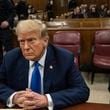Editor’s note: A longer version appears on my AJC.com.
Apparently the New Normal in the Trump presidency is to have large protests every weekend. The old adage about producing more heat than light applies here: There’s been a great deal of talk about the executive order President Donald Trump signed regarding refugees, much of which seems to based on emotion rather than fact.
Here is a list of things the Trump executive order is not:
A “Muslim ban.” Quick, which five countries have the largest Muslim populations? If you said Indonesia, India, Pakistan, Bangladesh and Nigeria, you’re correct. Those five countries are home to a combined 764 million Muslims, almost half of the world’s Muslim population. None of them was singled out in the executive order. In fact, only one of the top 10 countries for Muslim populations (Iran) is among the seven countries receiving greater scrutiny under the order. Trump’s halting the inflow of all aliens from those seven countries — not just Muslims from those countries — should have been a giveaway that the action was not a “Muslim ban.”
A significant change in policy regarding religion. Federal law already establishes religious persecution as one factor to be considered when granting asylum. Every reference to religion in the Trump executive order is to religious persecution, and the conditions apply only to members of a minority religion who are being persecuted. ISIS of course has killed a great many Muslims in majority-Muslim nations who simply didn’t subscribe to the would-be caliphate’s views on Islam. Perhaps there is enough discretion here to allow for granting asylum to Muslims threatened in this way, on the basis that the version of Islam they practice amounts to a persecuted minority sect in the eyes of ISIS, but that could stand to be much clearer.
Arbitrary. The seven countries specified by the order were identified by the Obama administration and Congress as potential sources of terrorism. In fact, they aren’t actually named in the order, which includes only a reference to the statute that identifies them.
The first time this has happened. The Obama administration, you may have forgotten, enacted a six-month freeze on refugee applications from Iraqis in 2011 after U.S. officials learned terror suspects had entered our country through the refugee program. At least one Iraqi who had helped U.S. troops and was seeking asylum was killed during the freeze.
A sound way to set policy. President Obama was roundly criticized — including by yours truly — for using executive orders to set policy that is more properly established by the legislative branch. The same criticism applies here to Trump. The new president has suggested the changes were urgently needed to protect the American people, but it’s far from clear such a broad policy was needed to prevent an imminent attack. If the government has specific intelligence about a possible terror plot, it would have been far better to use it to intercept possible suspects rather than to immediately cast a wide net — signaling to potential terrorists that they needed to change their approach.
Likely to add any meaningful protection to the homeland. While the chances of a terrorist taking advantage of our asylum program are not zero, they aren’t particularly large, either. We take in fewer, better screened refugees than the European nations whose problems have contributed to this concern.
In short, this situation reveals the worst of all worlds: An ill-conceived and poorly executed policy which opponents still manage to blow out of all proportion as something even nastier than it really is
About the Author





